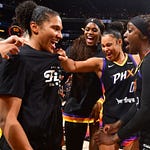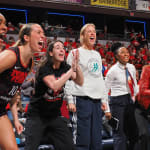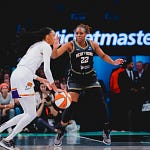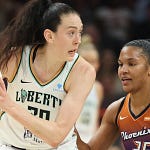Can you believe that the last competition date for the WNBA is in just 11 days and that, depending on how the next few Finals matchups , the season could be over by the end of this week? It’s been hard to wrap my head around how fast this summer and early fall went and how much the complexion of the sport has changed in such a short time.
There’s a lot of retrospection to be done once the final buzzer sounds but, for now, let’s focus on the present. Instead of the typical ‘Messy Monday’ we have in the WNBA, we ended up having a messy week. One could argue one of the messiest weeks in recent memory. In keeping with the code of the column, we’ll focus on the hoops first and then discuss some of the bigger cultural happenings in women’s basketball right now.
If you’d like to hear our full recap of the Las Vegas Aces game two win over the Phoenix Mercury in the WNBA Finals, it’s available here in podcast form. If you’re a part of our paid subscriber tier (consider it especially since our coverage goes straight from the W to the NCAA once the season is over), there’s something special at the bottom of the column for you!
Now, onto Five Out!
1. The Aces are doing what dynasties do…
It’s pretty remarkable how the Las Vegas Aces came back from the brink. Now just two wins away from their third title in four years, it feels incomprehensible that at one point this team was 14-14 during the regular season and we were basically writing their obituary. As Chelsea Gray told ESPN’s Michael Voepel after the Aces regular season win against Minnesota, “We could’ve went our separate ways and we just got tighter. It was looking a little scary but we had to turn it around. We never stopped believing in one another.”
We, as media, sometimes tend to try and find individuals to craft turnaround stories around. But in the case of Vegas, this is a really fascinating case of everyone just kind of figuring it out as the year went on. Nikki Fargas and Becky Hammon managed to retool the roster in a way that works (the Dana Evans move literally became the difference between a 2-0 Finals lead and a 1-1 series tie), players looked inward and got better while Hammon and her staff seem to have rediscovered their magic with the clipboard. Everything seems to be working again and those doldrum days of the 2024 and early 2025 season feel like a life time ago.
It feels like we tend to define sports dynasties by the amount of titles they win within a specific window. Sometimes, truly all-time dynasties are able to keep that window open for a prolonged period of time. While success is one indicator, I tend to believe that a team’s mentality also plays a role. What we saw in game two is a Las Vegas team that believes in their greatness again. At times over the last year and change, it’s felt like that belief has wavered as other contenders have arisen. Even in the semifinals series against Indiana, you saw a team of upstarts and a pair of all-WNBA players show no fear in the face of the league’s standard bearer for the past five years. At the end of the day, the Aces still prevailed. While some people might enjoy the parity of a different title winner every year and the unpredictability it brings, Las Vegas currently fills a great role in the current WNBA ecosystem.
They are the team of the moment, led by the best player in the league and arguably one of the greatest of all time, fighting off all comers who are trying to cement their own legacy. Does the ‘nobody believed in us’ shtick get a little old? Sure. But I think it’s fair to note two things: that many of us did indeed write the Aces off in June/July and that this is no different than any other dynasty in men’s sports. In order to maintain a certain level of excellence, you have to constantly find new slights, new motivators and haters to overcome. The great ones all know how to do it. Dawn Staley, Geno Auriemma, Nick Saban, Kirby Smart, Steve Kerr, you name it. Part of being an elite coach and organization is knowing how to get up no matter what. And now the Aces are two wins away from cementing their status as one of the great dynasties of the WNBA.
2. …But you’d be a fool to think the series is over.
With that in mind, the Phoenix Mercury are far from dead. Yes, game two was a belt-to-ass moment that challenged many preconceived notions about how this series was going to play out. But realistically speaking, we’re two made Alyssa Thomas free throws away from this being a 1-1 split heading back to Arizona. While I’m curious about the mental battle between these teams (and specifically their superstars) and whether or not the Mercury have that bounceback ability in such a crucial slate of games, the talent is undeniable.
It starts with Alyssa Thomas, who ran into early foul trouble in Michelob Ultra Arena and never really got into the flow that she is used to. For the first game of this 2025 postseason AT looked like a past version of herself (and not the good kind). The critique around the 33 year old superstar has always been what she can offer you deep in the playoffs. If Thomas is off-ball and not initiating the offense, how much of a threat is she really? With her off the floor due to that third foul in the first half, you could see just how much different the Mercury look. Turnovers, stagnant offense and a notable lack of physicality. It shows just how valuable AT is to the team’s success but it also exposes the flaw of orienting your team around a singular player.
To her credit, I have a feeling that the Mercury are going to figure it out over the course of the next few days. Nate Tibbetts has been outcoached so far this series by Becky Hammon but is a good tactical mind and should have some new wrinkles for the home stand. I don’t expect Phoenix to shoot 5/28 as a team from three point range at home either. But there are some things that have to improve, and fast. DeWanna Bonner needs to rediscover the form she had during the first series against New York while the Mercury’s other two superstars, Satou Sabally and Kahleah Copper, need to do better than a combined 5/17 from deep.
This is one of the tougher matchups for Phoenix but there is still a chance to take some games at home. On some level, I am concerned that Thomas missing those two free throws in game one fundamentally altered the trajectory of this series. But I just can’t bring myself to bury the Mercury just yet.
3. The Dallas Wings are in need of a head coach!
Curt Miller wins the “news dump of the year” award in the WNBA. I have a hard time believing a man as terminally online as the Dallas Wings general manager is didn’t see all the conversation around Napheesa Collier and Cathy Engelbert and think to himself ‘good time to drop this press release’. How long did Chris Koclanes’ firing stay in the news cycle? Maybe 24 hours? If you work in crisis communications, this was a masterclass in burying a headline.
Unfortunately for Curt, the only person more terminally online than him is the writer of this column.
While I’m not a fan of the increasingly short leash WNBA coaches are getting and the sky high expectations that seem to have been foisted upon them in the last few years, this is a rare situation where I think it needed to happen. Chris Koclanes, as nice of a guy as he appeared to be, seemed completely in over his head. Every now and then he would show some proficiency with in-game adjustments and the basic tactical coaching that is required to succeed in this league. But too often his lineup choices would be questioned, his offensive scheme around Paige Bueckers was confusing and his general affect towards his players was negative. That is not a recipe for a team trying to grow around one of the brightest young stars in the league.
Much like the Indiana Fever letting go of Christie Sides, the Dallas Wings at least seem to understand what they have in Bueckers and don’t want to mess it up. While some franchises seem content to be stubbornly about their system and way of doing things, firing Koclanes indicates to me that Dallas and their executive group are at least open to what this new era of the WNBA demands. With a new practice facility announced and arena renovations at the Dallas Convention Center underway, the time is now for the Wings to try and position themselves as more than what Chauny likes to call ‘Dallas Wings University’, a stopover program for WNBA players and coaches before they inevitably find success elsewhere.
Much like Seattle and New York, there will be plenty of good candidates for the job. And as I wrote in Five Out last week, I’m very curious about the potential inequities that can arise in this coming coaching search as teams begin to prioritize NBA experience. I do know this though, when Dallas does announce a coach, it won’t come on the heels of the biggest news item of the month.
4. The part of the ‘Unrivaled Conflict of Interest’ discussion we’re missing…
I wrote an essay last week detailing why this WNBA labor fight, punctuated by Napheesa Collier’s commentary about league commissioner Cathy Engelbert, is about more than just money. It laid out the pattern of disrespect shown towards women’s basketball since its first major breakthrough with Title IX. But I felt that the column was meandering and lacking the real punch of why this is all so important.
So over the weekend, I thought more about it and why there is such a backlash starting to form over Collier’s perceived conflict of interest as a co-founder of Unrivaled.
On the surface, I get why someone would think this way. If the WNBA enters a work stoppage, then Unrivaled stands to be the one to gain the most. They already have a TV deal, major sponsor and are positioning themselves whether they know it or not as a legitimate threat to the monopoly on women’s basketball run by the NBA/WNBA. The idea that Collier, according to this incredible story from Ramona Shelburne and Kendra Andrews at ESPN, did this without consulting anyone at the WNBPA is more evidence for those that believe she is trying to torpedo labor negotiations to accomplish her own ends.
But, if we zoom all the way out and look at this as an existential question about the future of women’s basketball, I would argue that Collier’s conflict of interest is actually a good thing. What people are having some difficulty parsing is the idea that this isn’t a battle between a player (and union representative) and a league commissioner. This is between the owner of one league and the representative for another. Given everything that’s come out in the time since, it appears that Collier is viewing this conversation as one between equals while Engelbert (and those she works for) do not. The disrespect that’s always been tacitly shown the WNBA, as I wrote last week, isn’t specific to the league. It’s a general disrespect towards the sport that women have been fighting for decades.
Yes, Collier going somewhat rogue isn’t a great look for the WNBPA if you look at things solely through the prism of the negotiations with the WNBA. But if you look at it from a “women’s basketball players vs. capital” argument, Unrivaled is the perfect leverage to force change. And if the WNBA/NBA don’t want that change, then the players can theoretically take their ball and go home. It’s the type of worker power many people crave in their own lives but hate to see others possess.
Fans can be forgiven for either not understanding or not embracing the fact that Collier is a unique case in terms of the labor fight. How could they? When the NBA and ABA were battling one another, there were no owner-players involved. It’s like the plot of Semi-Pro come to life but with an added wrinkle: Jackie Moon also happens to be one of the best players in the NBA.
“What happens to the non-Unrivaled players?” is a legitimate question. But that also ignores that there are three 5-on-5 leagues coming on line in the next year with the intention of being able to pull WNBA players. Athletes Unlimited is another avenue as is the European leagues. There is far more leverage than many fans even believe from an alternate playing options perspective.
If you’re the type of person that believes players should be entitled to more because their labor is the foundation on which a sports league is built, then a player-centric league is the platonic ideal and general endgame.
One can argue that what Collier is, on one level, advancing her interests. But that also assumes that she created Unrivaled with Breanna Stewart with solely capitalistic gain in mind. While money has undoubtedly been made by the venture, the mission statement has always been about providing a level of care for players that they’ve never received before. Inaugural players have equity in the league, received the highest average salary in U.S. women’s professional sports with a minimum six figure salary. The entire enterprise looks more like a worker’s cooperative than the single entity structure most professional sports leagues are.
And that’s what I missed in the first column. The end result of this labor fight in the WNBA is way bigger than any of us realize.
5. …And how this labor battle is a major inflection point for the American worker.
Think about it this way…
If there is a WNBA work stoppage that eventually culminates in Unrivaled going full 5x5 and basically becoming their own league, it sets a precedent for other players and leagues to follow. Over in the men’s basketball world Maverick Carter, LeBron James’ longtime business manager, is advising an international basketball league that is aiming to rival the NBA. It stands to reason that owners in the men’s league, which controls a major percentage of the WNBA, are using this labor fight as a training ground for the bigger fight that may come. Lindsay Gibbs drew attention last week to the NBA’s influence in the CBA negotiations and why Cathy Engelbert is, in essence, doing the job she is paid to do.
But beyond the sports implications, Unrivaled’s positioning as a worker-led, worker-centric organization is an existential threat to the billionaire and capital class that has just finished wrestling back control labor gains that were made post-2020. Under the surface, a major workers movement rooted in resentment over pay dissatisfaction, burnout, job insecurity and a lack of recognition. The biggest reason major actions like a general strike haven’t manifested is because of the comprehensive way in which the capital class has cowed their labor. Few can afford to lose their job in this economy, AI has effectively destroyed the hiring market while data shows that the turnover time for unemployed people to find work is becoming longer and longer.
One of the most successful and powerful unions in the country is SAG-AFTRA, representing most of Hollywood. While many high profile actors refused to join it, one of the biggest names in the film industry, Eddie Cantor, was an early advocate. A friend of then-President Franklin D. Roosevelt, Cantor was able to help break the studio’s monopoly on its’ labor through the suspension of provisions that included salary limitations and an ‘anti-raiding’ clause (we know them as non-competes).
What those that have had criticism for Collier are missing is that it requires people like her to kickstart movements like this. Unrivaled, and the players of the WNBA, have more leverage than ever. There’s an argument to be made that Collier’s choice to go solo in this pursuit makes it harder to trust her motives but the reality is that she is taking one of the most principled labor stands we’ve seen in sports in a long time. In truth, she (and Unrivaled by extension) are staking a position that could galvanize the American working class in a truly transformational way.
As I mentioned earlier, Unrivaled is a pseudo-worker’s cooperative in which the inaugural crop of players are owner-operators. It’s a fair question to ask if that model persists if there is a work stoppage but even the idea of labor exercising their power in this way is rare to see play out at this high of a level. But the idea of a league like Unrivaled breaking a corporate monopoly like the NBA/WNBA is the type of economic populism that feels universally supported even if opinions diverge on the means to reach the end.
Fans and writers don’t need to do the work of the NBA and WNBA ownership class for them. Ultimately, a work stoppage could be bad for the league and their players. It could stall progress and lead to less gains in a collective bargaining agreement. But the entire point of building up leverage in business negotiations is to eventually use it on a cause that is absolutely necessary. The WNBA is cagey and Cathy Engelbert is playing scared because they know that the possibility of a future in which the players win is an existential threat to the capital class in this country. If WNBA stars that are relatively financially secure recognize their power and can upend a monopolistic structure (one that, as many argue, has been more of an engine of tolerance than true support), then who else is capable of doing it?
A quick note for our subscribers!
Listen to this episode with a 7-day free trial
Subscribe to No Cap Space WBB to listen to this post and get 7 days of free access to the full post archives.











